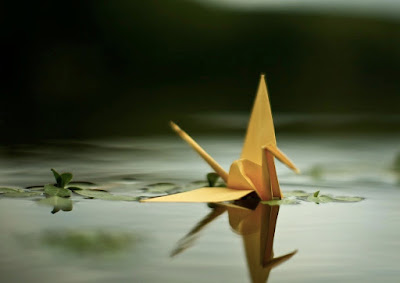I’m a music lover. Come to think of it, everybody loves music at one level or another. I haven’t met a person yet who said he/she doesn’t like music. I’m pretty sure that’s why it really is a universal language, much more understood than the seemingly simpler spoken words.
 |
| an origami paper crane |
Just yesterday, I heard something on the radio that I realized I’ve missed hearing for quite a while now. It was Hiroshima’s (FYI, it’s a jazz band not the city) Thousand Cranes. I suddenly remembered that many years ago, a decade or more perhaps, I heard that same song while listening to my husband’s favorite radio station. The disk jockey said something about it being inspired by a true story. Being perpetually interested to learn new things, my curiosity got the better of me and I felt I just had to call the station, Citylite 88.3, and ask the DJ to explain more about the song’s origin. How could I have forgotten that poignant story?!
Fortunately, the internet age is upon us right now so I just clicked on a search engine to refresh my memory. Oh yes, there are websites featuring the tale of how One Thousand Cranes came about. It is such a beautiful though sad story of hope. It is my privilege to share it with you…
 |
| can't count everything but this could reach up to a thousand cranes :) |
A Thousand Cranes for Peace
(source: http://www.johnworldpeacegalleries.com/1000cranes.html)
When Hiroshima was bombed on August 6th, 1945, the Sasaki family was spared. Or so it seemed. Sadako Sasaki was only two at the time, and until she was twelve, she grew strong and healthy. She was the fastest runner on her school relay team.
One day at school Sadako felt strange and dizzy, a feeling she would keep secret until weeks later, while running, everything seemed to whirl about her and she sank to the ground. Sadako had leukemia, "the atom bomb disease".
While she was in the hospital, her closest friend reminded her of the old Japanese legend that if she folded a thousand paper cranes, the gods might grant her wish to be well again. With courage and faith, Sadako began folding.
Though she was only able to fold 644 cranes before she died, Sadako had a profound impact on her friends and classmates. They completed her thousand cranes and raised money from school children all over Japan to build a statue to honor Sadako and all the children affected by the bomb.
 |
| Sadako Sasaki's monument |
Today, in Hiroshima's Peace Park, there is a statue of Sadako standing on top of a granite pedestal holding a golden crane in her outstretched arms. At its base a plaque reads:
This is our cry.
This is our prayer.
Peace in the world.
This is our prayer.
Peace in the world.
Every year, children from around the world fold cranes and send them to Hiroshima where they are placed around the statue. Because of Sadako, the paper crane has become an international symbol of peace.
Sadako wrote of her cranes: ' I will write Peace on your wings and you will fly all over the world.'
So, fellow music lovers out there, when you hear a song with such a beautiful melody with these lyrics "Show her now that we do care / with a love that we all share / send her a thousand cranes / send her your thousand cranes … " I hope you’ll also remember the story of that little girl who, with faith and courage, didn’t lose hope and in turn gave so many people the strength and encouragement to go on in spite of life's many challenges.






No comments:
Post a Comment